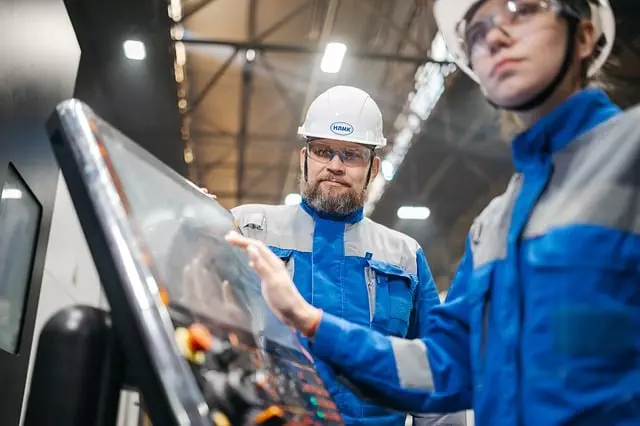Computational Fluid Dynamics (CFD) is a revolutionary technology transforming workplace air quality management and industrial ventilation design. By simulating fluid flow and temperature distribution, CFD helps engineers identify issues like stagnant zones and unsafe temperature gradients, enabling them to optimize ventilation systems. This ensures compliance with safety standards, improves indoor air quality, enhances energy efficiency, and ultimately creates healthier, safer working environments in various industries, including manufacturing and healthcare. Future advancements in CFD promise even more sophisticated solutions for workplace safety and comfort.
Computational Fluid Dynamics (CFD) is transforming industries by simulating fluid flow and heat transfer. This powerful tool, with its ability to model complex workflows, plays a pivotal role in enhancing workplace safety and efficiency, especially in industrial ventilation systems. By optimizing these systems through CFD, companies can significantly improve workplace air quality management and uphold stringent ventilation safety standards. This article explores the diverse applications of CFD, from foundational concepts to cutting-edge future trends, shedding light on its impact on occupational health and industrial practices.
- Understanding Computational Fluid Dynamics: A Foundation for Industrial Applications
- The Role of CFD in Workplace Air Quality Management
- Industrial Ventilation Systems: Modeling and Optimization with CFD
- Enhancing Ventilation Safety Standards through Computational Fluid Dynamics
- Real-World Applications: How CFD Improves Occupational Health and Safety
- Case Studies: Success Stories in CFD Implementation for Ventilation Systems
- Future Trends: Advancements in CFD Technology for Better Workplace Environments
Understanding Computational Fluid Dynamics: A Foundation for Industrial Applications
Computational Fluid Dynamics (CFD) is a powerful tool that enables engineers to simulate and predict fluid flow in complex systems. By understanding the intricate dance of fluids, from air currents to liquid flows, CFD forms the backbone of numerous industrial applications. In the context of industrial ventilation systems, for instance, this technology plays a pivotal role in ensuring workplace air quality management.
Engineers leverage CFD to model and optimize ventilation strategies, enhancing safety measures under various conditions. This is particularly crucial when adhering to stringent ventilation safety standards. By simulating scenarios, they can identify potential bottlenecks or areas requiring improvement, ultimately contributing to healthier and safer working environments.
The Role of CFD in Workplace Air Quality Management
Computational Fluid Dynamics (CFD) plays a pivotal role in enhancing workplace air quality management by simulating and predicting fluid flow and temperature distribution within industrial environments. This powerful tool is instrumental in optimizing ventilation systems, ensuring worker safety and comfort. By modeling complex scenarios, CFD analysts can identify areas of potential issues such as stagnant zones or excessive temperature gradients, allowing for proactive adjustments to be made in design and installation of industrial ventilation systems.
Adherence to robust ventilation safety standards is paramount in maintaining a healthy workplace environment. CFD offers a sophisticated means to verify compliance with these standards by accurately depicting the dispersion of pollutants and the effectiveness of exhaust systems. This data-driven approach enables professionals to make informed decisions, optimizing air quality management strategies while promoting a safer working atmosphere.
Industrial Ventilation Systems: Modeling and Optimization with CFD
Industrial Ventilation Systems: Modeling and Optimization with CFD play a critical role in ensuring workplace air quality management and maintaining ventilation safety standards. Computational Fluid Dynamics (CFD) offers a powerful tool to simulate and optimize these systems, allowing engineers to predict airflow patterns, temperature distribution, and the dispersion of pollutants or contaminants within enclosed spaces. By modeling various scenarios, from manufacturing facilities to office buildings, professionals can identify bottlenecks and inefficiencies in current ventilation designs.
This technology enables precise adjustments to be made to system components such as fans, ducts, and filters, leading to improved energy efficiency and enhanced indoor air quality. Moreover, CFD analysis aids in compliance with occupational health and safety regulations by ensuring that hazardous materials are effectively contained or dissipated, thus protecting workers from potential exposure.
Enhancing Ventilation Safety Standards through Computational Fluid Dynamics
Computational Fluid Dynamics (CFD) is transforming how we approach industrial ventilation systems and workplace air quality management. By simulating fluid flow and temperature distribution, CFD enables engineers to optimize ventilation designs for better safety standards. This advanced technique goes beyond traditional methods by offering a detailed, digital landscape of air movement within enclosed spaces.
This technology plays a pivotal role in enhancing ventilation safety standards. It allows for the identification of hot spots and areas with poor airflow, enabling designers and managers to implement targeted improvements. With CFD, workplaces can be designed or retrofitted to ensure better air circulation, reducing the risk of suffocation, heat stress, and other health hazards associated with inadequate ventilation.
Real-World Applications: How CFD Improves Occupational Health and Safety
Computational Fluid Dynamics (CFD) plays a pivotal role in enhancing occupational health and safety, particularly in industries where air quality is paramount. By simulating fluid flow and temperature distribution, CFD helps design and optimize industrial ventilation systems for better workplace air quality management. This technology ensures that employees are protected from hazardous airborne particles, gases, or fumes by accurately modeling how these contaminants disperse and accumulate within work environments.
In many cases, CFD analysis has led to significant improvements in ventilation safety standards. It allows professionals to identify hot spots and areas of poor airflow, enabling them to make data-driven adjustments to ventilation systems. This proactive approach not only prevents health risks but also contributes to a more productive and comfortable workplace. Moreover, by minimizing the need for costly trial-and-error methods, CFD streamlines the process of developing efficient and safe working conditions.
Case Studies: Success Stories in CFD Implementation for Ventilation Systems
Computational Fluid Dynamics (CFD) has proven to be a game-changer in optimizing industrial ventilation systems, ultimately enhancing workplace air quality management and ensuring compliance with ventilation safety standards. Several case studies highlight successful CFD implementations that have led to significant improvements in these areas.
For instance, one study focused on improving airflow patterns in a large manufacturing facility. By utilizing CFD simulations, engineers were able to identify and rectify stagnant zones within the workspace, reducing the risk of hazardous gas accumulation. This optimized ventilation design not only enhanced worker safety but also improved overall productivity by ensuring a fresh supply of clean air. Another successful application involved a healthcare facility where CFD was employed to design efficient HVAC (Heating, Ventilation, and Air Conditioning) systems, minimizing the spread of airborne diseases while maintaining optimal temperature and humidity levels. These examples illustrate how CFD can be a powerful tool in addressing real-world challenges related to industrial ventilation systems and workplace safety.
Future Trends: Advancements in CFD Technology for Better Workplace Environments
The future of Computational Fluid Dynamics (CFD) holds immense potential to transform workplace environments into safer and healthier spaces. With advancements in technology, CFD can enhance industrial ventilation systems, playing a pivotal role in workplace air quality management. By accurately simulating fluid flow and heat transfer, engineers can design more efficient and effective ventilation strategies, ensuring optimal air circulation and reducing harmful contaminants. This is particularly crucial in industries where worker safety is paramount, such as manufacturing and construction.
CFD simulations can also help in adhering to and surpassing ventilation safety standards. These sophisticated tools enable a deeper understanding of airflow patterns, enabling professionals to identify potential hazards and design mitigation strategies. As the technology continues to evolve, we can expect more sophisticated models that consider complex factors like chemical reactions, particle dispersion, and even human presence, thereby fostering a safer and more comfortable working atmosphere.


